RHETORICAL ANALYSIS OF PRESIDENT TRUMP POLITICAL SPEECH IN PALM BEACH, FLORIDA ON JANUARY 3RD, 2020 ON THE KILLING OF QASSEM SOLEIMANI
DOI:
https://doi.org/10.15575/call.v3i2.14946Abstract
This research analyzes rhetoric which is uttered by President Trump in his political speech in Palm Beach, Florida on January 2020 on the killing of Qassem Soleimani. The analysis involves its context, arguments, and also the effects caused by his speech. The research method used is descriptive qualitative method. The data were taken from the video, the transcript of the speech and the news related to the speech. Martin theory (2014) of rhetorical analysis on political speech and Cicero`s theory in Aristotle (2008) of the classical principle of rhetoric are used to analyze the data. The research results are the rhetorical context of President Trump`s speech is to respond and clarify the killing of Qassem Soleimani; and the accusation of started a war, thus the rhetorical argument shows that the speech used all the classical principle of rhetoric and the rhetorical effect of the speech is escalating the tension in the region.Â
Keywords: Political speech, rhetorical analysis, president Trump, Qassem Soleimani
References
Aristotle. (2008). The Art of Rhetoric. In W. R. Roberts (Ed.), Megaphoneebook. www.wendelberger.com
Covino, W., & Jollife, D. A. (1995). Rhetoric: Concepts, Definitions, Boundaries. Allyn and Bacon.
Cuncic, A. (2020). How to Read Facial Expressions. VeryWellMind. https://www.verywellmind.com/understanding-emotions-through-facial-expressions-3024851
Ekman, P. (1972). Universals and Cultural Differences in Facial Expressions of Emotions. In J. Cole (Ed.), Nebraska Symposium on Motivation (pp. 207–282). University of Nebraska Press.
Ilie, C. (2006). Rhetoric, Classical. In Encyclopedia of Language & Linguistics (2nd ed., pp. 573–579). Elsevier Ltd. https://doi.org/10.1016/B0-08-044854-2/04305-4
Kennedy, G. A. (1994). A New History Of Classical Rhetoric. Princeton University Press.
Kennedy, J. F. (1961). JFK’s Famous Inaugural Address Passage. https://youtu.be/PEC1C4p0k3E
Martin, J. (2014). Politics and Rhetoric A Critical Introduction (1st ed.). Routledge.
Martin, J. (2015). Situating Speech: A Rhetorical Approach to Political Strategy. 63(1), 25–42. https://doi.org/https://doi.org/10.1111/1467-9248.12039
Miller, W. L., & Benjami, F. C. (2000). Doing Qualitative Research. Sage Publication.
Moran, K. (2016). The Four Dimensions of Tone of Voice. Nielsern Norman Group. https://www.nngroup.com/articles/tone-of-voice-dimensions/
Murphy, J. J. (2006). Rhetoric: History. In Encyclopedia of Language & Linguistics (2nd ed.). Elsevier Ltd.
Sutherland, S. (2016). A Beginner’s Guide to Discourse Analysis. Red Globe Press.
Syarif, S. (2015). Rhetoric Analysis of Michelle Obama’s Speech at the Democratic National Convention On September 4th 2012. Alauddin State Islamic University.
Szczesny, S. (2017). Stylistic features of Barack Obama`s state of the union addresses. Leiden University.
Widyawardani, Y. I. (2016). RHETORICAL ANALYSIS OF DONALD TRUMP’S PRESIDENTIALCANDIDACYANNOUNCEMENT SPEECH [Universitas Sanaata Dharma Yogyakarta]. https://repository.usd.ac.id/4879/2/111214096_full.pdf
Downloads
Published
Issue
Section
Citation Check
License
Authors who publish in CALL agree to the following terms:
- Authors retain copyright and grant the journal right of first publication with the work simultaneously licensed under Attribution-ShareAlike 4.0 International (CC BY-SA 4.0) License that allows others to share the work with an acknowledgment of the work's authorship and initial publication in this journal.
- Authors are able to enter into separate, additional contractual arrangements for the non-exclusive distribution of the journal's published version of the work (e.g., post it to an institutional repository or publish it in a book), with an acknowledgment of its initial publication in this journal.
- Authors are permitted and encouraged to post their work online (e.g., in institutional repositories or on their website) prior to and during the submission process, as it can lead to productive exchanges, as well as earlier and greater citation of published work (See The Effect of Open Access).




